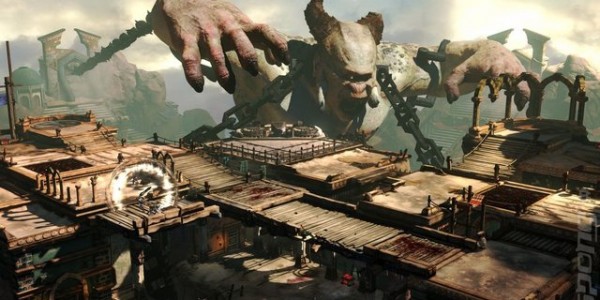If there’s a bright center to the God of War IP, Ascension‘s multiplayer is the mode that it’s furthest from. That’s not to say that the melee-focused brawler isn’t a joy to play. In fact, movement and combat controls are so analogous to the single-player controls from past GoW games that it’s a friendly addition, and one accented by the set pieces and Greco-Roman lore that the series gleefully brutalizes. This is a well-made enhancement to the GoW formula, and one that deserves attention. It’s also, I think, a weak link in Olympus’ chain.
The Kratos experience ports well to persistent multiplayer. Some mythical badass or another (in this case, heroes like Jason and Hercules) teams up with other muscular, oily legends to rip into some other jacked Aeneid cameos until weapons fall from Mount Olympus and somebody carves open the Cyclops, whose name, by the way, is Polyphemus. Doing so nets experience which nets new armor, weapons, and magic, and the next stage promises more of the same.
What’s less remarkable (in my short experience with the game, which is indicative of but not definitive for all experiences with it) is the actual process of skull-smashing and thorax-slashing, which is as much a game of violent PONG as chess is a game of strategic PONG. One player lays in with a killer combo, then rests in a cooldown, when the opponent gets swift and equal revenge. Then they each use magic, and the first one to recover and attack after that wins the duel. Tethering (using chains to pull towards an enemy) adds a touch of variety to combos, but is just an extension of the same back-and-forth combat.
That’s actually a small component, as it turns out, of the play, as environmental traps, level traversal, and pickup weapons and refills dot the battlefield inviting a bit of turnabout. As one might imagine, these are all best used i concert with a teammate – the antithesis to Kratos’ one-man-army approach – which breaks down quickly after the start of play. No doubt, a month after release players will have a more nuanced schema for tactically breaking down the opposing team, but the newb’s take is as important as any.
Most concerning in the current gameplay demo for Ascension is the lightning round of a fatality that ends the match. After a short animation shows a spear falling from the sky, both teams race towards the landed weapon to be the first to activate a long, scripted sequence that involves cutting open poor Polyphemus’ face (he just wanted some sheep, guys) and finishing off his one good eye in the process. This is alarming not because of the predictable level of grotesque myth-dismantling, but the almost game-breaking amount of points attributed to this seemingly arbitrary steeple chase. According to the developers, these moments in multiplayer levels win matches, to the point of being tactically superlative to the prior ten minutes of vicious, tooth-and-nail bloodletting.
With only one stage in front of the public and nine months left in development, there’s ample time for balancing and beta testing to place value back onto player action and away from set-piece triggers. Regardless of how the matches even out, Ascension’s multiplayer looks to be a largely successful, bold gamble for a series with such an intense following and clear tradition.



















Forget Smash Bros. and PS All-Stars; THIS is the multiplayer brawler that I’m looking forward to!